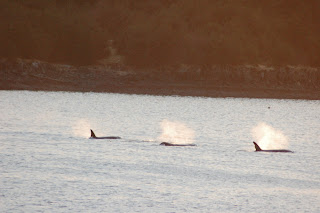

More About Orcas
Here are more whale pictures, taken this summer. Notice how straight the dorsal fins are in these males, compared to the last blog's females with curved dorsal fins on the prior blog. They say the male’s straight fins can stick up to 7 feet , but I have only seen them stick up about 3-4 feet.
Concerning how they live: there are three lifestyles. The ones we saw might actually be local or Resident whales. More is known about Residents than any other group.Their pod stay in shallow water and within a small geographic area most of the time. The family stays together and the males go out of their pod when they are ready to mate, at about the age of 15, but typically 21. I do not know if they return to their family or join the mate's. These guys like to eat salmon.
Transient whales travel over large geographic areas and are the ones who love to eat sea mammals, unlike the other two that prefer salmon or schools of fish in the open ocean.
Offshore whales live in the deep seas and like to eat schools of fish, particularly herring. Some people blame the decrease in the herring population on the increasing wild whales since hunting has been outlawed. I've read that misbehaving Resident or Transient whales are moved out to be loner offshore whales.
Anyway, cows breed till about the age of 40 and have about 5 offspring in their life. They nurse their babies for about 2 years. In the Resident group, both the male and females take care of the new one's upbringing. Females' average lifespan is 50 years and some have reached 90! Males typically reproduce starting at age 15 - 21, but their lifespan is only 29 years. Occasionally a male reaches 40 or 50.
As far as their name, Killer Whale, the English picked this up from the Spanish's asesino de ballena, which really means "killer of whales". That is because these are really dolphins with teeth and, at least the Transient ones, use those teeth to bite the jaws off true toothless whales. They follow those injured real whales till they get weak and then use them for food. At least that is what some Transients have been seen to do. And that apparently is what happened last year to the baby true whale that washed up on our beach with no jaw and other parts bitten off. But, as far as attacking humans, that apparently has never been shown to have happened.... except in captivity theme parks, where they have attacked their keepers.
Last year I thought I had a pod following our ferry boat and got all excited. But then I realized we were going only at 12-15 knots and those guys were not keeping up with us after a few minutes. Orcas can cruise at 25 knots and reach 35 at their peak. Then I realized they were awful small, about 6-7 feet instead of the expected 15-20 for a female or 20-25 for a male Orca. I can’t imagine a group of small baby Orcas without their big mammas around. No, they were either White Sided or Peale's dolphins. Their top is as black as an Orca and they have white on their bottom, but they are the size of a regular dolphin. Shows you how, in the heat of the moment, you can see what you want to see, and not what is really in front of you.


